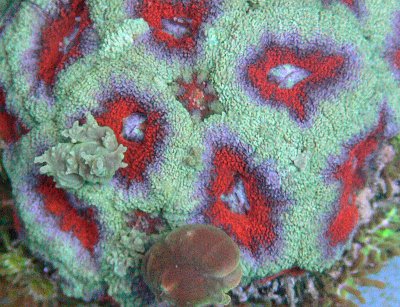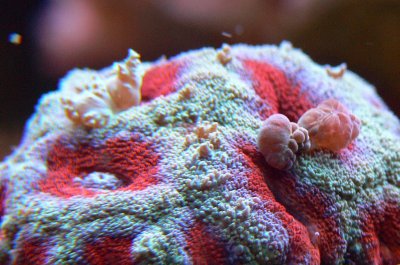Navigation
Install the app
How to install the app on iOS
Follow along with the video below to see how to install our site as a web app on your home screen.
Note: This feature may not be available in some browsers.
More options
You are using an out of date browser. It may not display this or other websites correctly.
You should upgrade or use an alternative browser.
You should upgrade or use an alternative browser.
LPS id please
- Thread starter acabgd
- Start date
- Tagged users None
- Joined
- Jul 13, 2017
- Messages
- 1,006
- Reaction score
- 698
The texture and structure really looks like an Acan Echinata to me. But, I’m not 100% sure. Coral species identification can be tough.
It looks like acans to me. I hope someone can chime in that can be sure of what it is. I have one small acan colony that is starting to get similar bubbles on it.
Dave
Dave
Any idea where this "Acan" was collected from ... regionwise? Aussie or Vietnam? Okay here we go .... Bounce Acan mania!!! 
No idea where this one came from. Got it from another reefer who was tearing down his tank. He didn't have much idea.Any idea where this "Acan" was collected from ... regionwise? Aussie or Vietnam? Okay here we go .... Bounce Acan mania!!!
Definitely looks like an Acanthastrea! Are the edges of each of the polyps "tied down" or connected to each other/the skeleton?
It looks to me to be either acanthastrea lordhowensis vs acanthastrea echinata.... kinda hard to tell!
It looks to me to be either acanthastrea lordhowensis vs acanthastrea echinata.... kinda hard to tell!
The edges of polyps look almost as being a single coral, tightly packed together. I have never seen them apart, but I know they are. However, the coral heads are wayyyy more packed together than the "usual" Acans (mostly Lords) I have seen.
The edges of polyps look almost as being a single coral, tightly packed together. I have never seen them apart, but I know they are. However, the coral heads are wayyyy more packed together than the "usual" Acans (mostly Lords) I have seen.
You know, i've been wondering this for a while, and more and more anecdotal evidence i see keeps pointing to it... i really need to see if someone has research published on it: these animals obtain their nutrients by diffusion of the elements through the water. The animal uses it, and there is a elemental gradient around the animal that causes more of those missing elements to come and fill the void (stagnant water). But then you add in things like flow to help provide a consistent source or boundary layer concentration so to speak allowing the animals to have as much as they need/want to build their bodies up. But I wonder by what mechanism these animals take in these nutrients from the water, whether that is also passive diffusion into their bodies, or whether there is active transport into their bodies. It seems apparent to me that there is some form of active transport within the body between cells/polyps.... and i'm sure the mechanisms are going to be different for soft vs hard vs sps vs lps. Ugh i miss research...
Anyway, i digress, the rant above was just to say that these unique "morphs" of the physically and genetically the same corals we find is definitely attributed to environmental factors. I'm sure many of us have witnessed a coral in the store, then we take it home, and in short time it's growth habit is totally different in our tank. Or how, i've heard, some people say some rhodactis turn into "bounces" because of exposure to highly actinic lighting etc.. etc.. One of my favorite parts about ID'ing corals is that their environment, throughout their life really, changes the way each specimen looks slightly. So this little one may me an enchinata with more puffy meat on it, or, it may be a lordhowensis and have had the conditions that allow each of it's corallites to tightly pack, with small interstitial growths.
Its pretty incredible to think about actually, the adaptability of these animals....but maybe not so much when you consider that while our primitive ancestors were clawing their way out of the ocean and figuring out how to live on land, today's sea-dwelling creatures' ancestors were evolving to their original environment, becoming be more highly evolved and specialized and efficient in their domain. So exciting. All of that is basically why i'm into this hobby...that and teaching people about whats under the surface of the ocean and why it is so important to this planet when they come over and see my tank.
You know, it definitely isn't a common coloration for sure. But i swear i've seen it before on some puppy-mill-coral-monger site like aquariumdepot.com or something like that...looks more like a lord to me but not like any I have seen before. Not just the bubbles but the color pattern.
Regardless, OP, thats a pretty acan. And unless you can get one of the coral pros on here like UniqueCoral's Joe Caparatta (really awesome guy if you ever get to meet him) or of similar caliber, you might not be able to know exactly which type of acan it is. I've had masses of folks online ID my really unique turbinaria sp. as an acro and insist that I just need to wait for it to plate out before it begins to branch and then i'll see they're right.... only to have it plate out to a softball diameter and confirm it's a turbinaria haha
Which you were closer! I'd love a piece of that beautiful coral
Thanks for the detailed comment. It's funny sometimes how little we actually know about the corals we keep, although we look at them every single dayYou know, it definitely isn't a common coloration for sure. But i swear i've seen it before on some puppy-mill-coral-monger site like aquariumdepot.com or something like that...
Regardless, OP, thats a pretty acan. And unless you can get one of the coral pros on here like UniqueCoral's Joe Caparatta (really awesome guy if you ever get to meet him) or of similar caliber, you might not be able to know exactly which type of acan it is.
















